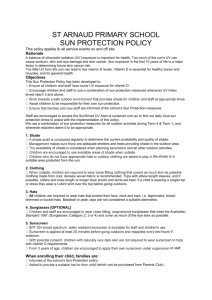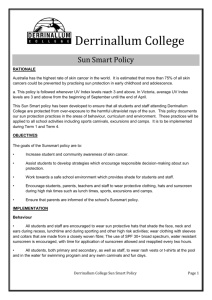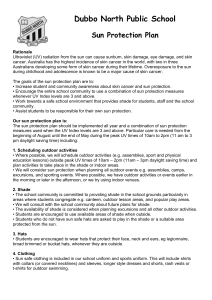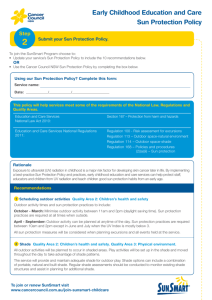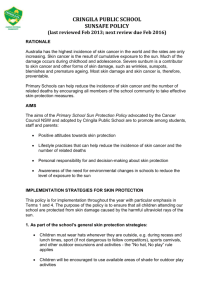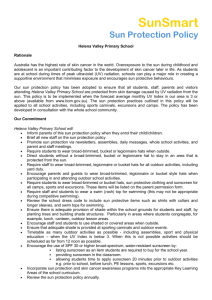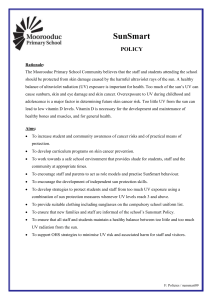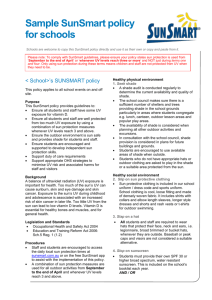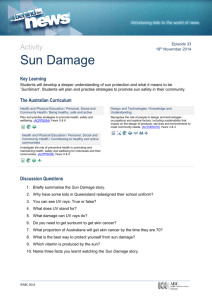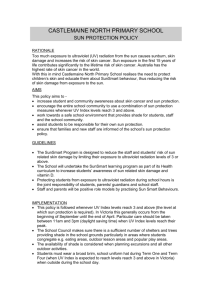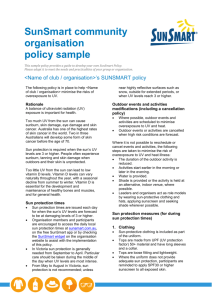Schools are welcome to copy this SunSmart sun protection policy
advertisement
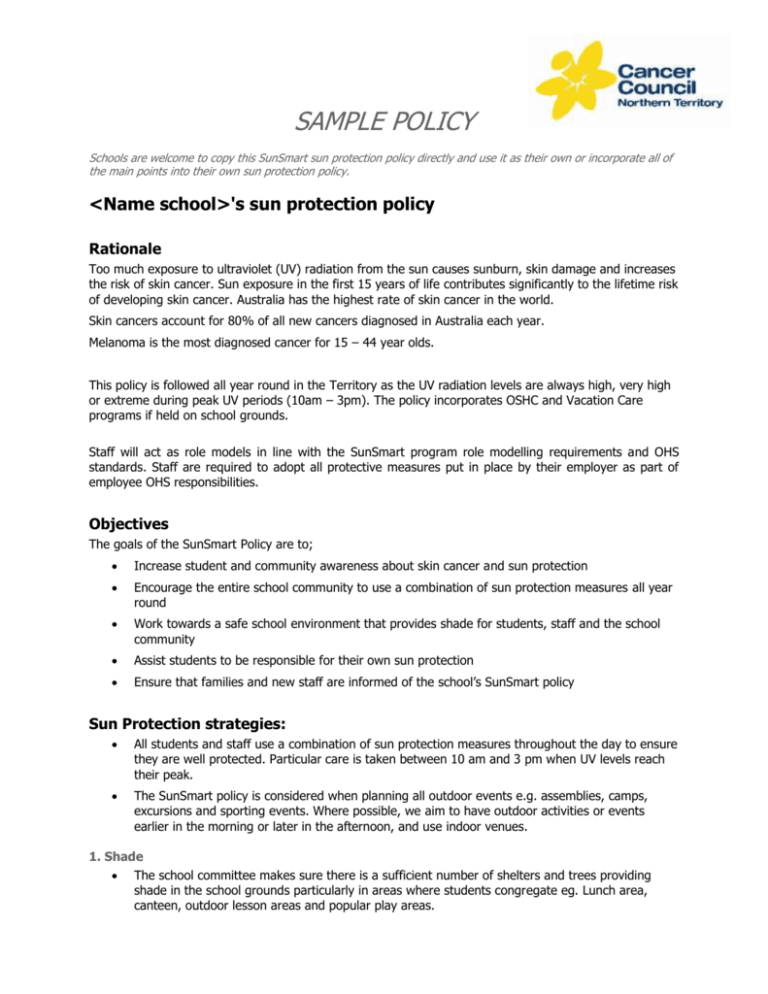
SAMPLE POLICY Schools are welcome to copy this SunSmart sun protection policy directly and use it as their own or incorporate all of the main points into their own sun protection policy. <Name school>'s sun protection policy Rationale Too much exposure to ultraviolet (UV) radiation from the sun causes sunburn, skin damage and increases the risk of skin cancer. Sun exposure in the first 15 years of life contributes significantly to the lifetime risk of developing skin cancer. Australia has the highest rate of skin cancer in the world. Skin cancers account for 80% of all new cancers diagnosed in Australia each year. Melanoma is the most diagnosed cancer for 15 – 44 year olds. This policy is followed all year round in the Territory as the UV radiation levels are always high, very high or extreme during peak UV periods (10am – 3pm). The policy incorporates OSHC and Vacation Care programs if held on school grounds. Staff will act as role models in line with the SunSmart program role modelling requirements and OHS standards. Staff are required to adopt all protective measures put in place by their employer as part of employee OHS responsibilities. Objectives The goals of the SunSmart Policy are to; Increase student and community awareness about skin cancer and sun protection Encourage the entire school community to use a combination of sun protection measures all year round Work towards a safe school environment that provides shade for students, staff and the school community Assist students to be responsible for their own sun protection Ensure that families and new staff are informed of the school’s SunSmart policy Sun Protection strategies: All students and staff use a combination of sun protection measures throughout the day to ensure they are well protected. Particular care is taken between 10 am and 3 pm when UV levels reach their peak. The SunSmart policy is considered when planning all outdoor events e.g. assemblies, camps, excursions and sporting events. Where possible, we aim to have outdoor activities or events earlier in the morning or later in the afternoon, and use indoor venues. 1. Shade The school committee makes sure there is a sufficient number of shelters and trees providing shade in the school grounds particularly in areas where students congregate eg. Lunch area, canteen, outdoor lesson areas and popular play areas. In consultation with the school council, shade provision is considered in plans for future buildings and grounds. The availability of shade is considered when planning excursions and outdoor activities. Students are actively encouraged to use available areas of shade when outside. Students who do not have appropriate hats or outdoor clothing are asked to stay in an area protected from the sun. 2. Clothing All styles of school uniform will include collars that protect the neck, and sleeves. Shorts, dresses and skirt lengths will extend as close to the knee as possible. School clothing is made of close weave fabric. Rash vests or t-shirts will also be worn when swimming outdoors. (Please note: Cap sleeves are not considered sun protective and are therefore not acceptable). 3. Hats Students are also required to wear hats that protect their face, neck and ears, i.e. bucket or broad-brimmed whenever they are outside. (Please note: Baseball caps are not considered sun protective and are therefore not acceptable.) Students who do not have an appropriate sun protective hat will be asked to stay in shaded areas only. 4. Sunglasses [SUGGESTED] Students and staff are encouraged to wear close fitting, wrap around sunglasses that meet the Australian Standard 1067 (Sunglasses: Category 2, 3 or 4) and cover as much of the eye area as possible. 5. Sunscreen SPF 30+ broad spectrum, water resistant sunscreen is available for staff and student's use. Time Sunscreen is applied at least 20 minutes before going outdoors and reapplied every two hours as required. Time will be allocated for sunscreen application prior to outdoor activities. Role Modelling Staff act as role models by: wearing sun protective hats (broad brimmed, bucket or legionnaire hats), clothing and sunglasses outside (please note that baseball caps do not offer enough protection and are therefore not acceptable) applying SPF 30+ broad spectrum, water resistant sunscreen seeking shade whenever possible Families and visitors are encouraged to use a combination of sun protection measures (sun protective clothing and hats, sunglasses and sunscreen) when participating in and attending outdoor school activities. Curriculum Sun protection and skin cancer awareness programs are incorporated into appropriate areas of the school curriculum. Students are encouraged to be involved in initiatives to promote and model sun protection measures to the whole school community. SunSmart behaviour is regularly reinforced and promoted to the whole school community through newsletters, school homepage, parent meetings, staff meetings, school assemblies, student and teacher activities and on student enrolment. Review The school council and staff monitor and review the effectiveness of the sun protection policy every two years and revise the policy when required. Next policy review: . . . . . . . . . . . . . . . Please attach your school’s sun protection policy to your completed application/agreement form and return it to us at: SunSmart Schools Program The Cancer Council Northern Territory PO Box 42719 Casuarina NT 0811 For further information about your sun protection policy or the SunSmart Schools Program, please contact Cancer Council Northern Territory Ph: June 2011 Email: 08 8927 4888 FAX: 08 8927 4990 healthpromotion@cancernt.org.au
